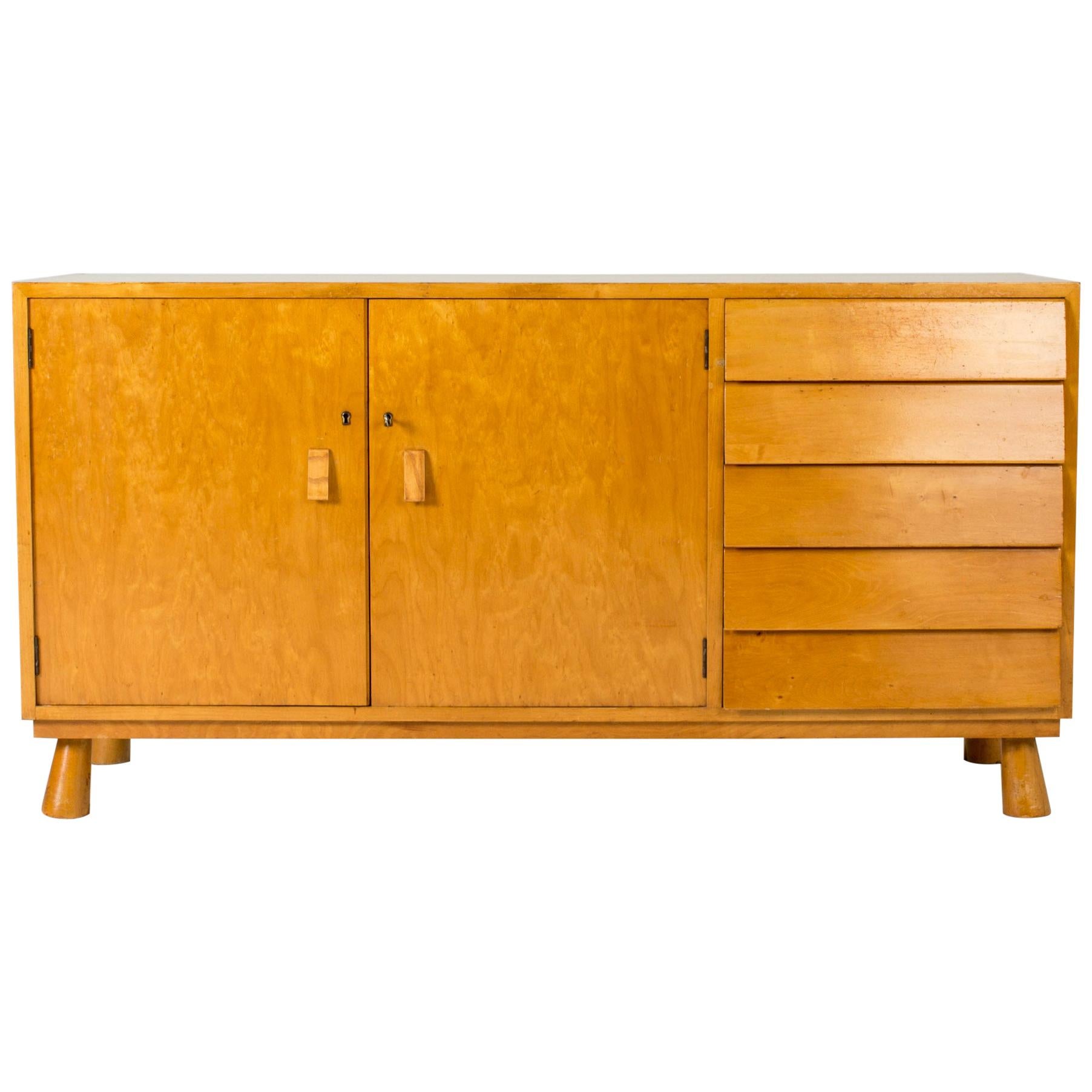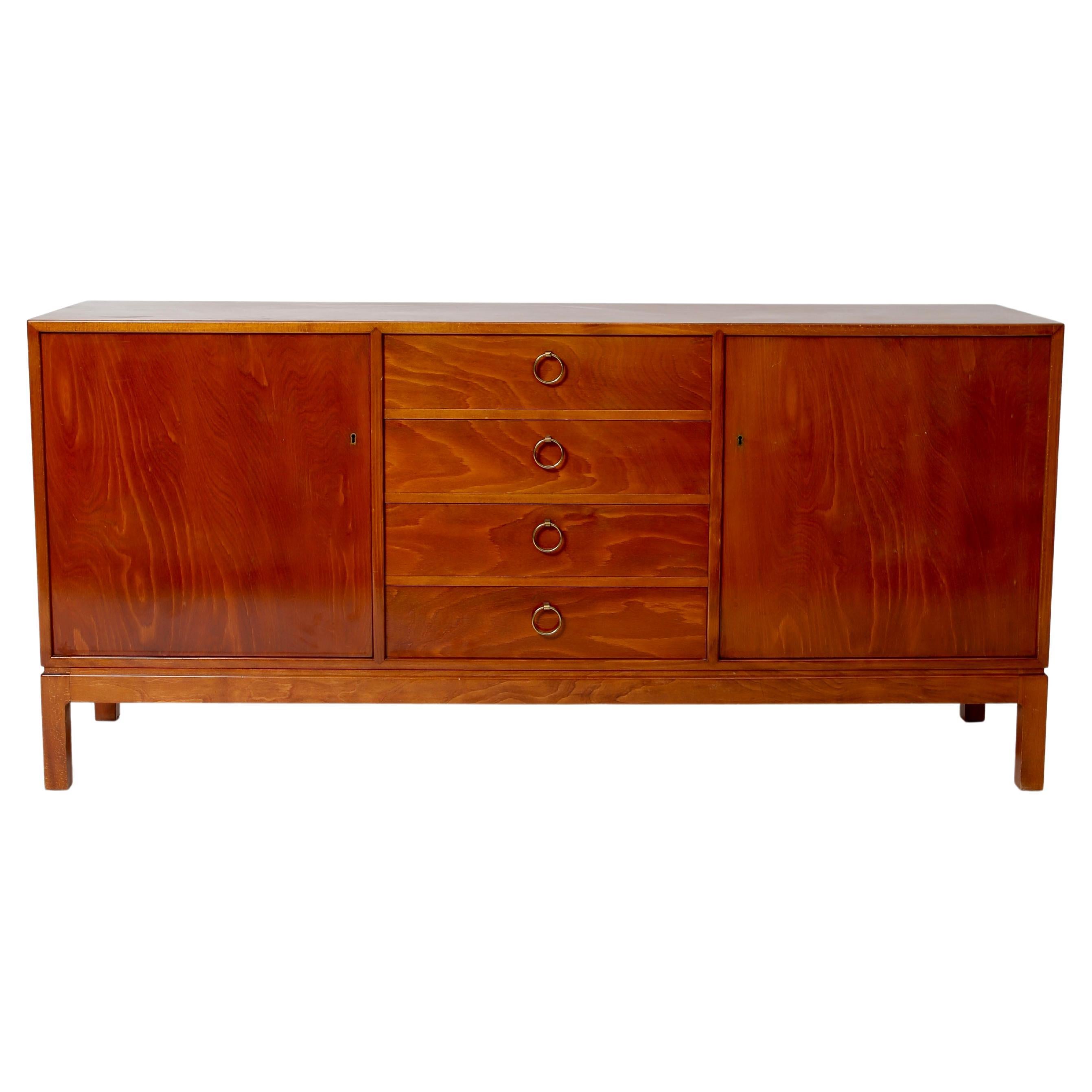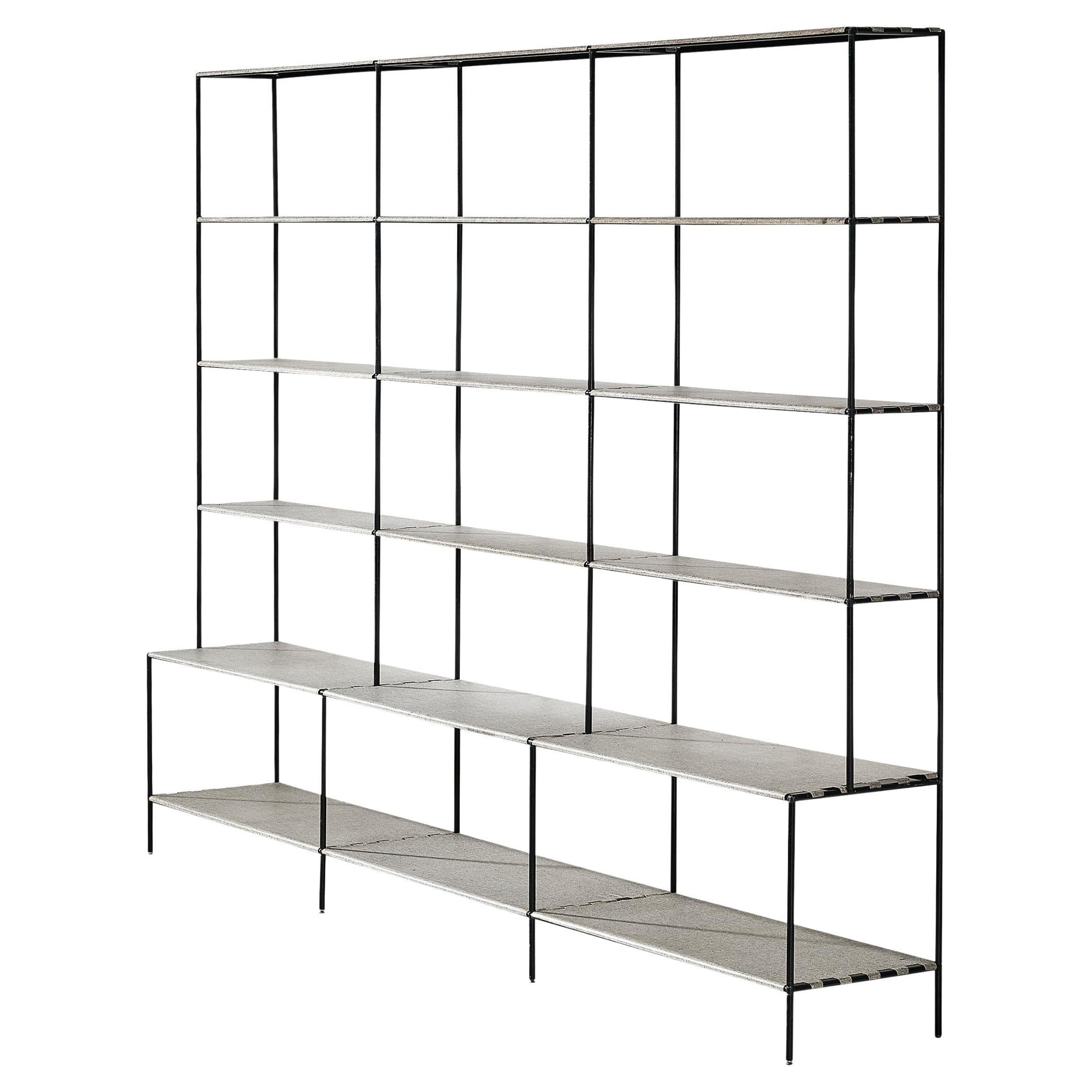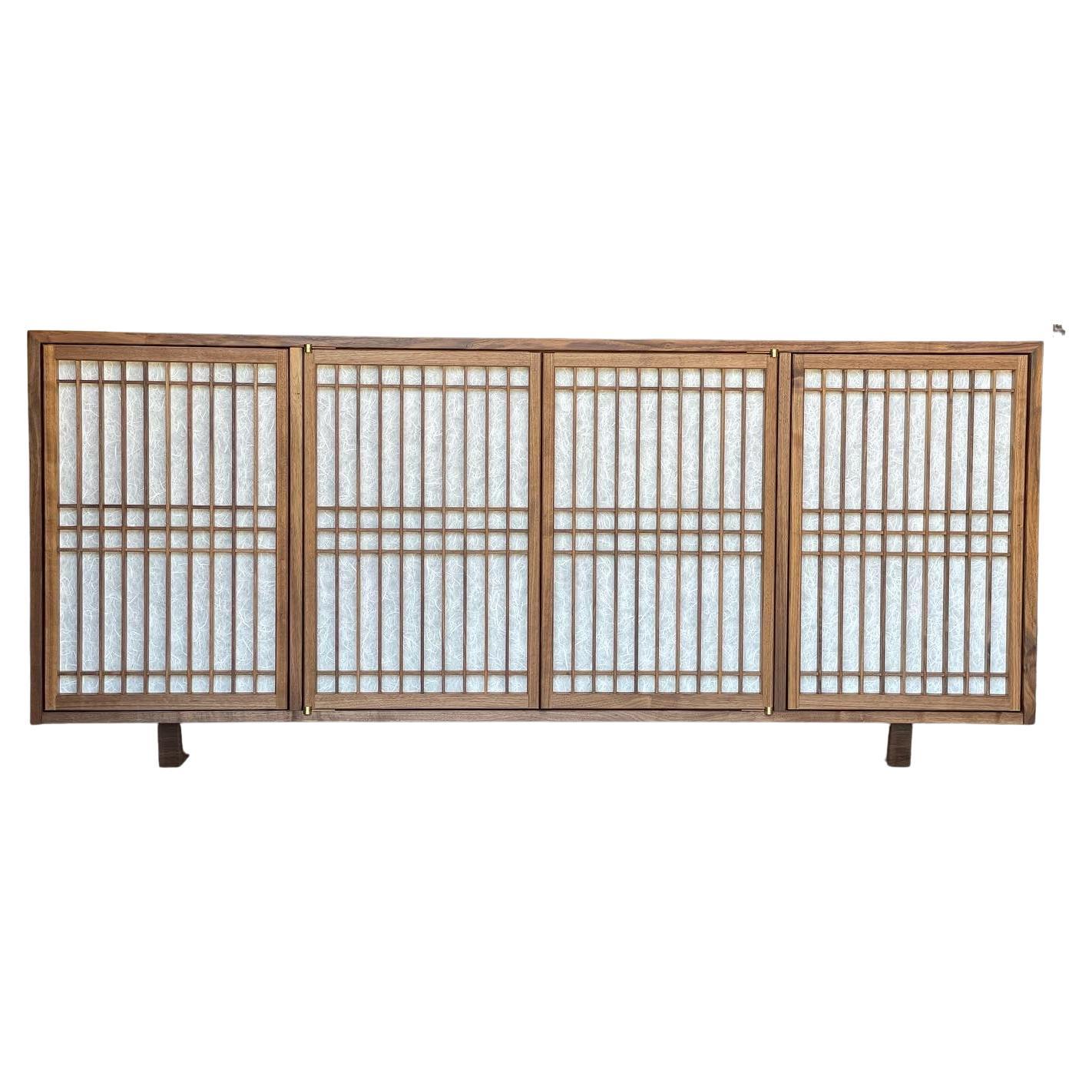Items Similar to Functionalist Room Divider Denmark, 1930s
Want more images or videos?
Request additional images or videos from the seller
1 of 11
Functionalist Room Divider Denmark, 1930s
About the Item
Rare Functionalist Room Divider and Jardinieres made in Denmark in the 1930s in lacquered plywood.
This piece is the perfect room divider since it lacquered on both sides and therefore can be free standing, but it can also be used as a sideboard or a jardinieres since it has the room in the top which is perfect for your favourite plants.
This piece is a great example of Danish Functionalism and has similarities to pieces by architects like Vilhelm Lauritzen, Frits Schlegel, Arne Jacobsen and Kaj Gottlob who all were pioneers in danish modernism and have had a big influence on the coming generations of architects.
This room divider comes from a danish house build in the 1930s and was a original part of the interior.
This piece is the perfect decorative piece for any interior and will fit any style from typical scandinavian to the more modern interior or art deco or wabi sabi style interior.
- Dimensions:Height: 27.56 in (70 cm)Width: 59.06 in (150 cm)Depth: 7.88 in (20 cm)
- Style:Scandinavian Modern (Of the Period)
- Materials and Techniques:Plywood,Lacquered
- Place of Origin:
- Period:
- Date of Manufacture:1930s
- Condition:Reupholstered. Additions or alterations made to the original: later lacquered white, the piece was originally lacquered grey. Minor losses. the piece has minor veneer damage which has no effect on the pieces condition.
- Seller Location:Valby, DK
- Reference Number:1stDibs: LU6559233044972
About the Seller
5.0
Vetted Seller
These experienced sellers undergo a comprehensive evaluation by our team of in-house experts.
1stDibs seller since 2022
25 sales on 1stDibs
Typical response time: <1 hour
- ShippingRetrieving quote...Ships From: Valby, Denmark
- Return PolicyA return for this item may be initiated within 2 days of delivery.
More From This SellerView All
- Evan Jensen Bronze Vase, Denmark, 1930sBy Evan JensenLocated in Valby, 84Rare bronze vase attributed Evan Jensen made in Denmark in the 1930s. The vase is made by a unknown danish caster called Antika but is a typical Evan Jensen shaped vase and has typical Evan Jensen detail. The vase is in good condition with a beautiful original patina. Art Deco, short for the French Arts Décoratifs, and sometimes just called Deco, is a style of visual arts, architecture, and product design, that first appeared in France in the 1910s (just before World War I), and flourished in the United States and Europe during the 1920s and 1930s. Through styling and design of the exterior and interior of anything from large structures to small objects, including how people look (clothing, fashion and jewelry), Art Deco has influenced bridges, buildings (from skyscrapers to cinemas), ships, ocean liners, trains, cars, trucks, buses, furniture, and everyday objects like radios and vacuum cleaners. It got its name after the 1925 Exposition internationale des arts décoratifs et industriels modernes (International Exhibition of Modern Decorative and Industrial Arts) held in Paris. Art Deco combined modern styles with fine craftsmanship and rich materials. During its heyday, it represented luxury, glamour, exuberance, and faith in social and technological progress. From its outset, Art Deco was influenced by the bold geometric forms of Cubism and the Vienna Secession; the bright colours of Fauvism and of the Ballets Russes; the updated craftsmanship of the furniture of the eras of Louis XVI and Louis Philippe I; and the exoticized styles of China, Japan, India, Persia, ancient Egypt and Maya art. It featured rare and expensive materials, such as ebony and ivory, and exquisite craftsmanship. The Empire State Building, Chrysler Building, and other skyscrapers of New York City built during the 1920s and 1930s are monuments to the style. In the 1930s, during the Great Depression, Art Deco became more subdued. New materials arrived, including chrome plating, stainless steel and plastic. A sleeker form of the style, called Streamline Moderne, appeared in the 1930s, featuring curving forms and smooth, polished surfaces. Art Deco is one of the first truly international styles, but its dominance ended with the beginning of World War II and the rise of the strictly functional and unadorned styles of modern architecture and the International Style of architecture that followed. This vase is the perfect detail for any interior from the modern Wabi Sabi style...Category
Vintage 1920s Danish Scandinavian Modern Vases
MaterialsBronze
- Evan Jensen Bronze Dish, Denmark, 1930sBy Evan JensenLocated in Valby, 84Bronze Art deco dish/charger by Danish artist Evan Jensen from the 1930's in a beautiful original condition, the dish is signed Evan Jensen Copenhagen Bronze and has model number 320. The dish has a very decorative image of a deer on the front. The dish is the perfect dish to have standing as a piece of art but can also be used as a bowl to store stuff like fruit or nuts or whatever else you could think of. Art Deco, short for the French Arts Décoratifs, and sometimes just called Deco, is a style of visual arts, architecture, and product design, that first appeared in France in the 1910s (just before World War I), and flourished in the United States and Europe during the 1920s and 1930s. Through styling and design of the exterior and interior of anything from large structures to small objects, including how people look (clothing, fashion and jewelry), Art Deco has influenced bridges, buildings (from skyscrapers to cinemas), ships, ocean liners, trains, cars, trucks, buses, furniture, and everyday objects like radios and vacuum cleaners. It got its name after the 1925 Exposition internationale des arts décoratifs et industriels modernes (International Exhibition of Modern Decorative and Industrial Arts) held in Paris. Art Deco combined modern styles with fine craftsmanship and rich materials. During its heyday, it represented luxury, glamour, exuberance, and faith in social and technological progress. From its outset, Art Deco was influenced by the bold geometric forms of Cubism and the Vienna Secession; the bright colours of Fauvism and of the Ballets Russes; the updated craftsmanship of the furniture of the eras of Louis XVI and Louis Philippe I; and the exoticized styles of China, Japan, India, Persia, ancient Egypt and Maya art. It featured rare and expensive materials, such as ebony and ivory, and exquisite craftsmanship. The Empire State Building, Chrysler Building, and other skyscrapers of New York City built during the 1920s and 1930s are monuments to the style. In the 1930s, during the Great Depression, Art Deco became more subdued. New materials arrived, including chrome plating, stainless steel and plastic. A sleeker form of the style, called Streamline Moderne, appeared in the 1930s, featuring curving forms and smooth, polished surfaces. Art Deco is one of the first truly international styles, but its dominance ended with the beginning of World War II and the rise of the strictly functional and unadorned styles of modern architecture and the International Style of architecture that followed. This dish is the perfect detail for any interior from the modern Wabi Sabi style...Category
Vintage 1930s Danish Scandinavian Modern Decorative Dishes and Vide-Poche
MaterialsBronze
- Evan Jensen Bronze Vase, Denmark, 1930sBy Evan JensenLocated in Valby, 84Evan Jensen bronze art deco vase made by Danish artist Evan Jensen in the 1930s. The vase is in a beautiful original condition and is signed Evan Jensen København Bronze and has model number 155A. The vase is a beautiful decorative element to any interior and the structure of the vase is fantastic with lots of details which will give you endless hours of enjoyment looking at. Art Deco, short for the French Arts Décoratifs, and sometimes just called Deco, is a style of visual arts, architecture, and product design, that first appeared in France in the 1910s (just before World War I), and flourished in the United States and Europe during the 1920s and 1930s. Through styling and design of the exterior and interior of anything from large structures to small objects, including how people look (clothing, fashion and jewelry), Art Deco has influenced bridges, buildings (from skyscrapers to cinemas), ships...Category
Vintage 1930s Danish Scandinavian Modern Vases
MaterialsBronze
- Bronze vase by HF ildfast Denmark 1930sBy IldfastLocated in Valby, 84Rare Art Deco Bronze vase by Danish manufacturer HF Ildfast Bronze made in Denmark in the 1930’s, the vase carries the original patina which has been ma...Category
Vintage 1930s Danish Scandinavian Modern Vases
MaterialsBronze
- Just Andersen Art Deco Light Bronze Dish Denmark 1930sBy Just AndersenLocated in Valby, 84Just Andersen Art Deco dish in beautiful patinaed light bronze made in Denmark in the 1930's. This dish is the perfect piece as a decorative element but can also be used as a fruit or nut bowl or whatever else you could think of. The dish is signed Just Andersen LB 1734. Art Deco, short for the French Arts Décoratifs, and sometimes just called Deco, is a style of visual arts, architecture, and product design, that first appeared in France in the 1910s (just before World War I), and flourished in the United States and Europe during the 1920s and 1930s. Through styling and design of the exterior and interior of anything from large structures to small objects, including how people look (clothing, fashion and jewelry), Art Deco has influenced bridges, buildings (from skyscrapers to cinemas), ships...Category
Vintage 1930s Danish Scandinavian Modern Decorative Dishes and Vide-Poche
MaterialsBronze
- Agentor Art Deco Bronze tray Denmark 1930sLocated in Valby, 84Beautiful patinaed Art Deco Bronze dish by danish manufacture Agentor from the 1930's. The Dish has the motive of a woman running with her hunting dog next to her. This dish is the perfect piece as a decorative element but can also be used as a fruit or nut bowl or whatever else you could think of. The dish is signed Agentor Bronce number 47. Art Deco, short for the French Arts Décoratifs, and sometimes just called Deco, is a style of visual arts, architecture, and product design, that first appeared in France in the 1910s (just before World War I), and flourished in the United States and Europe during the 1920s and 1930s. Through styling and design of the exterior and interior of anything from large structures to small objects, including how people look (clothing, fashion and jewelry), Art Deco has influenced bridges, buildings (from skyscrapers to cinemas), ships, ocean liners, trains, cars, trucks, buses, furniture, and everyday objects like radios and vacuum cleaners. It got its name after the 1925 Exposition internationale des arts décoratifs et industriels modernes (International Exhibition of Modern Decorative and Industrial Arts) held in Paris. Art Deco combined modern styles with fine craftsmanship and rich materials. During its heyday, it represented luxury, glamour, exuberance, and faith in social and technological progress. From its outset, Art Deco was influenced by the bold geometric forms of Cubism and the Vienna Secession; the bright colours of Fauvism and of the Ballets Russes; the updated craftsmanship of the furniture of the eras of Louis XVI and Louis Philippe I; and the exoticized styles of China, Japan, India, Persia, ancient Egypt and Maya art. It featured rare and expensive materials, such as ebony and ivory, and exquisite craftsmanship. The Empire State Building, Chrysler Building, and other skyscrapers of New York City built during the 1920s and 1930s are monuments to the style. In the 1930s, during the Great Depression, Art Deco became more subdued. New materials arrived, including chrome plating, stainless steel and plastic. A sleeker form of the style, called Streamline Moderne, appeared in the 1930s, featuring curving forms and smooth, polished surfaces. Art Deco is one of the first truly international styles, but its dominance ended with the beginning of World War II and the rise of the strictly functional and unadorned styles of modern architecture and the International Style of architecture that followed. This dish are the perfect detail for any interior from the modern Wabi Sabi style...Category
Vintage 1930s Danish Art Deco Decorative Dishes and Vide-Poche
MaterialsBronze
You May Also Like
- Swedish Functionalist Sideboard, 1930sLocated in Stockholm, SEStriking Swedish functionalist sideboard from the 1930s. Neat size, with a set of drawers with slanted fronts on one side. Matching slanted handl...Category
Vintage 1930s Swedish Scandinavian Modern Cabinets
MaterialsBirch
- Danish Teak Tambour Door Sideboard Room DividerLocated in Kensington, MDA Danish modern teak sideboard / room divider. Featuring tambour doors that slide open to reveal four felt lined drawers & two adjustable shelves. The backside is fully finished, all...Category
Mid-20th Century Danish Mid-Century Modern Sideboards
MaterialsTeak
- Danish Art Deco 1930s Sideboard by Fritz HansenBy Frits Hansen/Soren HansenLocated in Portland, ORA stately sideboard in stained beech with lovely brass hardware. Designed and produced 1930s Denmark by Fritz Hansen, this cabinet is labeled to reverse side. All original finish wi...Category
Vintage 1940s Danish Scandinavian Modern Sideboards
MaterialsBrass
- Important French Room Divider, 19th CenturyBy France"Located in Madrid, ESTitle: French room divider Date/Period: XIX Century Dimension: 183cm x 165cm. Materials: Wood, Glass Additional Information: French Room Divider from the 19th century, in gilded ...Category
Antique Early 19th Century French Rococo Sideboards
MaterialsWood
- Poul Cadovius Wall Unit or Room DividerBy Poul CadoviusLocated in Waalwijk, NLPoul Cadovius, open bookshelf or room divider, metal, Denmark, 1960s This sizable and minimalist shelving unit was designed by Poul Cadovius. This shelving system exists of a thin f...Category
Vintage 1960s Danish Mid-Century Modern Shelves
MaterialsMetal
- Walnut Media Cabinet Room Divider with Shoji DoorsBy Brian HolcombeLocated in Princeton, NJWalnut cabinet made by hand and featuring shoji doors and shelves. This cabinet is constructed utilizing time honored joinery techniques featured in Japanes...Category
2010s American Sideboards
MaterialsWalnut
Recently Viewed
View AllMore Ways To Browse
1930s Living Room Furniture
Used Divider
Living Room Vintage Style Interior
Room Divide
Room Dividing
Vintage Divider
Danish House
Danish 1930s
House Of Denmark Used
Functionalist Furniture
Lacquered Plywood
1930s Danish Modern
Great Room Divider
1930s Modernism
Danish Decorative Pieces
Danish Standing
Vintage Style Room Divider
Plywood Used For Cabinets





